|
|
The 'Mr Big' with fortune of £50 million |
|
HE WAS Mr Big - the man who made millions by dealing in drugs, and the man who aimed to stay at the top of his sinister world by dealing in death. He was the so-called Angel of Death who offered cunning and corruption as the twin weapons with which to fight the combined police forces of Australasia. But the Angel came down to earth when Lancashire police swooped on the luxury £250-a-week Kensington apartment he had rented to mastermind the "English Connection". Terence Alexander Sinclair had found wealth in an evil trade. He once boasted he couldn't even spend the interest on a personal fortune of £25 million. But it wasn't always like that for the one-time welder born 36 years ago in New Zealand. He was a small-time crook, first coming to the attention of the police at 18, as Terry Clark, appearing in court at regular intervals between 1962 and 1971, when, on his ninth appearance he was jailed for five years for burglary and receiving. He had married at the age of 20, to a childhood sweetheart but was divorced in the second year of his sentence. The following year he remarried - in the prison chapel. His best man was Errol Hicksman, the New Zealander who was to become his trusted lieutenant and who stood with him in the dock at Lancaster Castle. His bride was a telephonist who was to die from a drugs overdose in September 1977, as was another girlfriend of Clark, just three weeks later. Clark liked what he heard during those years inside. After his release he was to become a cannabis customer of Mr Asia Marty Johnstone. Then he moved into the big league. Cocaine and heroin were to become his stock in trade. In 1975 he was named in court as the brains behind a massive £50,000 heroin shipment into Auckland - the biggest the country had known. |
He was arrested but skipped bail and vanished to Australia where he was to spend two profitable years before being picked up after a marijuana raid, fined and deported for possessing a revolver and suspected stolen cash. Back in New Zealand the prospect of many years behind bars faced Clark. But at his trial he was acquitted..... and later it was rumoured that he had spent £120,000 "buying" witnesses and "preparing" his case. Lessons Freedom for Clark was the signal to delve into the massive hidden reserves he had built up. He bought a prestige house overlooking the Bay of Islands on New Zealand's North Island for close on £250,000. Soon he was to be seen in a white Jaguar sports car. It was all go with his new image - of a man who had successfully rehabilitated himself after his earlier problems. So too was his change of name to Terence Alexander Sinclair, charged here as Alexander James. |
He bought prime beach property at Fiji worth more than £50,000. He is reported to have paid four years fees in advance for his son from his first marriage to attend a top New Zealand school. But Sinclair was handing out lessons of his own. Doug and Isobel Wilson, recruited by Sinclair to help distribute heroin, were found dead in a shallow grave near Melbourne after turning police informants. At their inquest a warrant was issued for the arrest of Sinclair for murder. A master of disguise - Sinclair could easily look like a man in his fifties - and armed with a stock of false passports and up to 23 aliases, crossing the globe was no problem. He jetted to Singapore, Britain and America. Gruesome In Britain he knew he his evil expertise could earn him more and more millions from drugs. But there was another thorn in his side - another security risk. That man was Marty Johnstone. Sinclair described as "very decent and considerate" by Karen Soich's mother, could not have dreamed a team of Lancashire detectives would burst into his Kensington flat a fortnight after the gruesome discovery of Johnstone's body. But as the New Zealand Inland Revenue Dept lodged a claim for £300,000 dollars back tax, the trappings of wealth remained even in his cell as a category 'A' prisoner on remand at Strangeways. Not for him prison food. Every day he paid for meals to be brought in from a top hotel. So was the wine - and best cigars. But was his confidence on the wane? The man described by the head of homicide at Melbourne as having "money coming out of his ears" found one Lancashire detective exceedingly deaf when he asked him to get three tickets to South America. Was the man who never thought he would be caught suddenly seeing the future as life behind bars in Britain - prison food and all? He WAS Mr Big... |
|
|
|
DRUGS and death kept the "Kiwi Connection" in business for more than four years. And what a business it was. Millions made in a matter of days. A gang of addicts and one-time petty crooks living in the life of fabulous luxury. The rewards for loyalty were immense - the price paid for treason even higher. The syndicate silenced squealers with ruthless efficiency. At least a dozen couriers died as triggermen purged the flourishing organisation of security risks. Ironically the last to be killed was Marty Johnstone - victim of the cancerous greed he started spreading five years before. In 1974 he was a hard-up salesman. By the time he died in 1979 he was worth millions. So too were others who controlled the biggest dope ring Australia has ever known. Conservative estimates put the earnings of the "Kiwi Connection" in five years at 250 million N.Z. Dollars (£125 million). Authorities will never know for sure. Sinclair once bragged he was worth £50 million - give or take a million or two. And police in five countries are still looking for Johnstone's nest egg, hidden away in property, safe deposit boxes and bank accounts under a host of fictitious names around the globe. One Australian detective with years of big-time crime fighting under his belt could find only these words to describe the size of the operation: "Bloody mind-boggling". A senior officer in England put it another way: "They were spending more on phone calls in a night than we were getting in a month's salary." FearWhatever the syndicate was worth it was determined to kill to keep it. To stay in business the "grasses" had to go. One was Londoner Harry Lewis who emigrated from Manor Park in search of the good life. Instead he found a cruel death. "Pommy Harry" became embroiled in syndicate trafficking between New Zealand and Australia. He died on bail for a drugs offence because his bosses feared he had talked to his captors. |
A rough justice for the squealers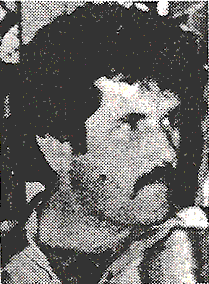 ABOVE: "Pommy" Harry Lewis - found without hands or teeth. It was feared he would talk. BELOW: Isobel and Doug Wilson - they did talk and were "taken out" by a contract killer.  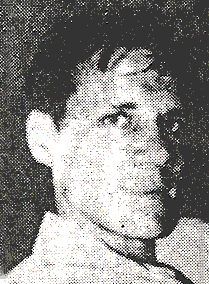 Last seen alive in the Sydney Hilton Hotel, he was found months later - shot and minus hands and teeth - in a New South Wales holiday resort. Lewis's execution was used by syndicate chiefs as a warning to others - but it went unheeded. Two more couriers, Greg Ollard and Julie Thielman, vanished after word reached the gang the couple were being tailed by police. They were addicts and could not be trusted to stay silent. Police are sure their bodies lie beneath the runway at Sydney Airport. For almost three years bodies turned up all over Australia. Margaret Clayton, 26, was shot twice in the head as she worked in a Melbourne massage parlour. Mary Hission, 24, was found shot and tied to a ship's anchor at the bottom of Sydney Harbour. |
The remains of the body of a young man were discovered on the outskirts of Melbourne with at least 12 stab wounds in the back. Another man was found hanging from a tree in New South Wales. The Killings stretched overseas. A gunman shot dead 17-year-old Margaret Bell outside a nightclub in Aukland, New Zealand. Yvonne Crosby and her six-year-old daughter Lisa were gunned down in Eastern France. But the murders which brought police nearest of all to the syndicate came on Good Friday, 1979, when Doug and Isobel Wilson were "taken out" by a contract killer. The couple, who together had a heroin habit costing £40,000 a year, talked at length when arrested for trafficking in Brisbane. They named names and spoke of corrupt officials. Soon after release they were lured from their luxury home in Sydney and shot in Melbourne. The "hit man" - cold blooded when faced with two traitors - could not bring himself to kill their pet dog. Then he made an uncharacteristic error. He broke the terms of his £120,000 contract and buried their bullet-riddled bodies in a shallow grave instead of putting them through a meat mincer as ordered. Not long after they were found, police began closing in on the people named by the Wilsons to narcotics agents in Queensland. Arrests might have resulted but for tip-offs from the syndicate's corrupt contacts. The organisation had penetrated the Federal Bureau of Narcotics in Canberra and had been making use of information from its giant computer. The discovery rocked the nation and led to a full-scale inquiry. Warrants were issued for two men - one of them Sinclair. His face, in various disguises, was shown on television and in newspapers all over Australia. But the slightly-built New Zealander had already fled the country. Later, after his arrest in Britain, he was to boast his sources were so good the organisation would be tipped off within minutes. He was even able to buy the tape of the Wilsons talking to police in Brisbane. "I've got money and money buys anything," he told a Lancashire detective. |
The syndicate had contacts in many fields helping its sordid business to flourish. Fake passports, birth certificates and other official documents were all bought for a price. The "Kiwi Connection" had the money and the expertise. It even ran a school for smugglers where new couriers were trained to beat the customs net. SympathyThey were mostly attractive women, dressed in fine clothes and dosed with valium to keep their cool. Dirty clothes were packed against false compartments of suitcases to discourage a closer look and for sympathy. Drug pockets were lined with plastic or fibreglass to make them undetectable even by trained "sniffer" dogs. Couriers got £1,000 a trip and risked the death penalty in the far East to make their bosses millionaires with every consignment. When Lancashire police finally broke the operation wide open in 1979 they found it had more than 90 people around the world. Sinclair and a handful of assorted ranks were under lock and key. But the vast majority were free and went rapidly to ground. For a time they left an empire in ruins, addicts without supplies. In New Zealand heroin all but vanished from the streets. KillingsBut soon the inevitable battle began for control of what was left. New distributors moved in to push supplies around the Australian continent. Only last December four were arrested bringing £750,000 worth of heroin through Sydney Airport. One was the man whose picture appeared next to Sinclair's on wanted posters after the Wilsons' killings. Police in Britain, New Zealand and Australia are justifiably proud to have destroyed one evil supply line. But they know only too well others have already taken its place. |
Lancashire Evening Post
No. 28,791 MONDAY OCTOBER 15, 1979 9p
POLICE PROBE MYSTERY OF BUTCHERED CORPSE
|
Police forces throughout the country were checking missing person files to try and identify the man - thought to be the victim of a bizarre gangland-style execution. The naked, mutilated corpse of a stocky man thought to be under 30 was found by amateur scuba-divers at Marsden's Quarry, off Halfpenny Lane, Eccleston, near Chorley. The frogmen say both hands had been chopped off the body and there was a large gaping wound in the stomach The long haired victim of the grisly gangland-type killing had been weighed down by bricks. Police refused to disclose the nature of their initial investigations but were holding a Press conference this morning. The gruesome discovery was made in a 60ft deep pool. The body, found by accident when sub-aqua enthusiasts Jeff Ashcroft, 22, a mechanic, and his pal Ian Reading, 34, were diving at the scene yesterday. Hours after the discovery, Jeff said "We had been diving about 60ft and were working our way round the side of the quarry to see if we could find anything interesting. When we first saw it we thought it was a tailor's dummy" The couple prodded the corpse before realising what it was. Ian, a lorry driver, added "It was only when we got close to it that our stomachs turned over and we found we had a body on our hands". The divers - both from Ashton-in-Makerfield near Wigan and members of the Newton-Le-Willows Scuba club - both believe the body had not been in the water for long. SCENE Lancashire CID chief Det Chief Supt Wilf Brookes and Assistant Chief Constable Keith Brown were immediately called to the scene. Chorley Chief Supt Ian Hunter and Supt Phil Cafferty of the No. 2 District Task Force based in Penwortham were also at the murder spot, 50 yards down Halfpenny Lane. The man in charge of the hunt is Det Supt Ray Rimmer, second in command of the Lancashire CID. Local anglers continued to fish at the quarry unaware of the drama unfolding 60 feet below. The water has been used in the past for the illegal dumping of cars, and both divers say they saw cars deep below the surface. A dumped mini estate was found near the body. But police are understood to have ruled out any link between that car and the body. Police frogmen later made a detailed search of the scene to try and find the man's severed hands and the murder weapon - but have been unsuccessful so far. A dental specialist has also been called in in a bid to help identify the victim. And Home Office pathologist Dr Geoffrey Garrett was carrying out a post-mortem. Lancashire police have no record of any local missing person who would fit the bill of the victim. The body has now been removed from the quarry and is in Preston Royal Infirmary mortuary. Article by Bob Westerdale & Peter Richardson |
From early times
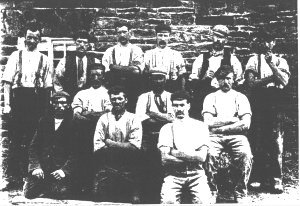 Eccleston Delph has been known as the Eccy Delph, or Hurst House Delph for the last century, and was mined by 12 local quarrymen producing stone for Blackpool Promenade and thin slates to cover the local barns and roofs.
Eccleston Delph has been known as the Eccy Delph, or Hurst House Delph for the last century, and was mined by 12 local quarrymen producing stone for Blackpool Promenade and thin slates to cover the local barns and roofs.
The Family of "Hurst" who originally owned and worked the Quarry, were well known in the area as Mr Hurst was Chairman of the Parish Council of Heskin for 20 years.
In 1930 the quarry became known as Marsh's Quarry, or Marsh's Delph.
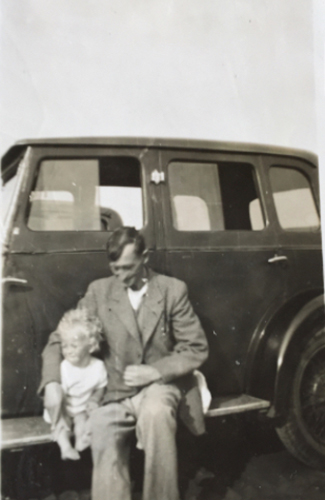 |
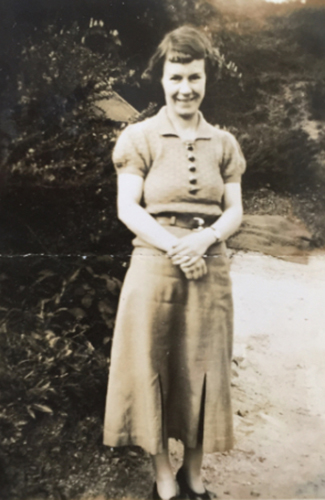 |
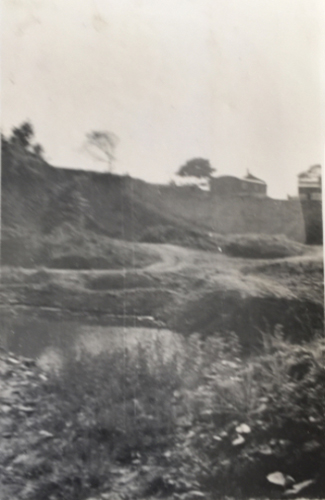 |
|
Frederick Marsh ran the quarry from 1930 until his death in 1934, when his wife Freda took over. |
Freda Marsh ran the quarry from 1934 to 1940/41. |
View of the quarry in the 1930's |
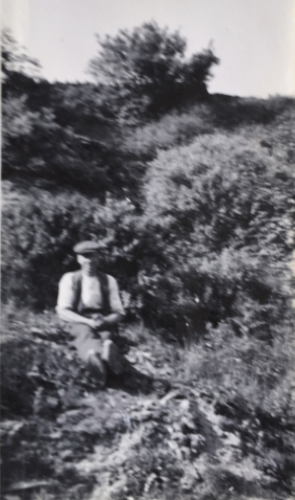 |
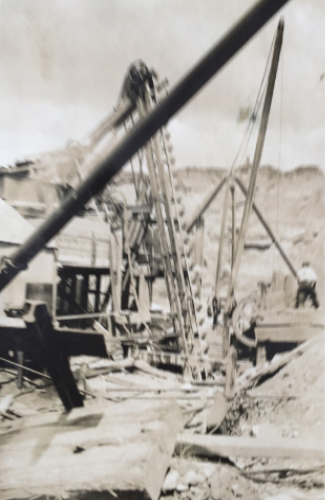 |
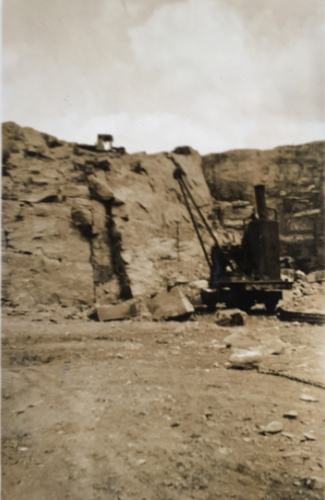 |
|
Quarry worker 1930's |
The Delph 1930's |
The Delph 1930's |
Many thanks to Maureen and Bob Marsh for providing the photo's and history of Marsh's Delph in the 1930's and 1940's.
Nature Fights Back
After Freda Marsh left the quarry the pumps clearing the water were turned off and the natural spring began to fill the quarry, becoming what was considered a natural beauty spot.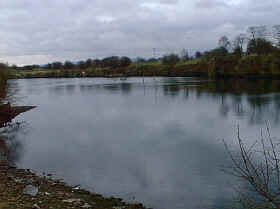
1990's and 80's
Neil Smitham, Chairman of the Trafford Sub-Aqua Club has kindly given us permission to share these pictures.
 Taken in the early 90's, a group from the club on the beach.
Taken in the early 90's, a group from the club on the beach.
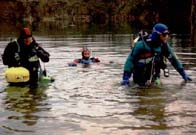
Taken 8/4/95 in the early evening.
They dived for 43 mins in a three to a depth of 9.5 meters and vis was a max of 3ft!!
Walking on water
These two were taken in the 1980's
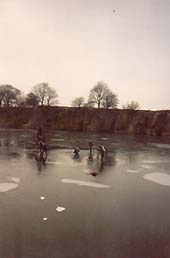
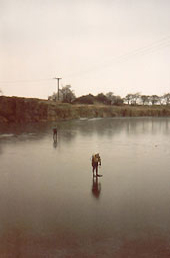
The Handless Corpse
October 15, 1979
Eccleston Delph, a flooded quarry in the heart of Lancashire, was never meant to reveal it's gruesome secret. But the body of Martin Johnstone never hit the bottom. The naked, mutilated corpse was found by amateur scuba divers. Read all about it here

Page 2 of 2


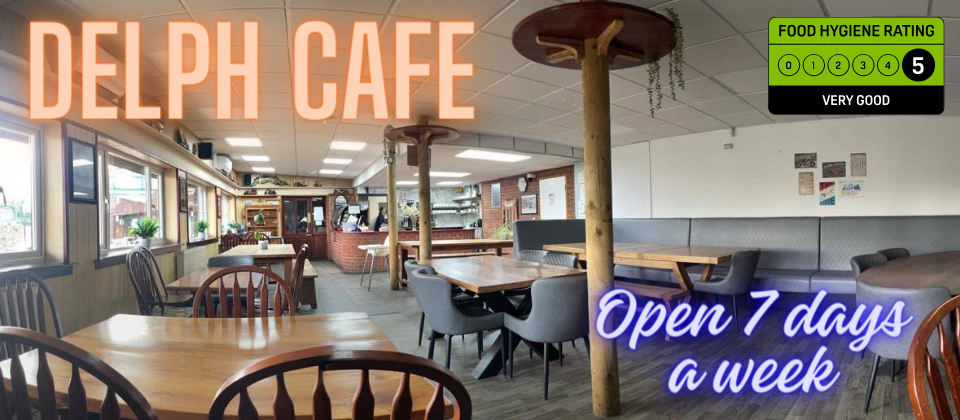

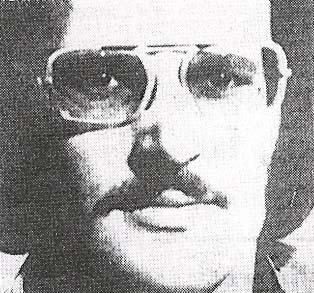
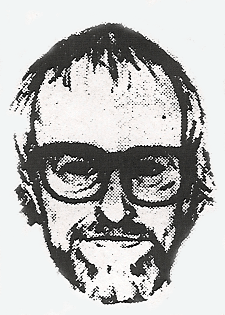
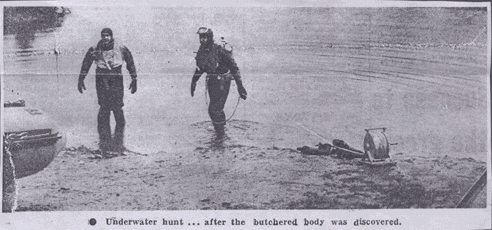 Detectives today stepped up a murder hunt after the butchered body of a man was found dumped in a flooded Lancashire quarry.
Detectives today stepped up a murder hunt after the butchered body of a man was found dumped in a flooded Lancashire quarry.